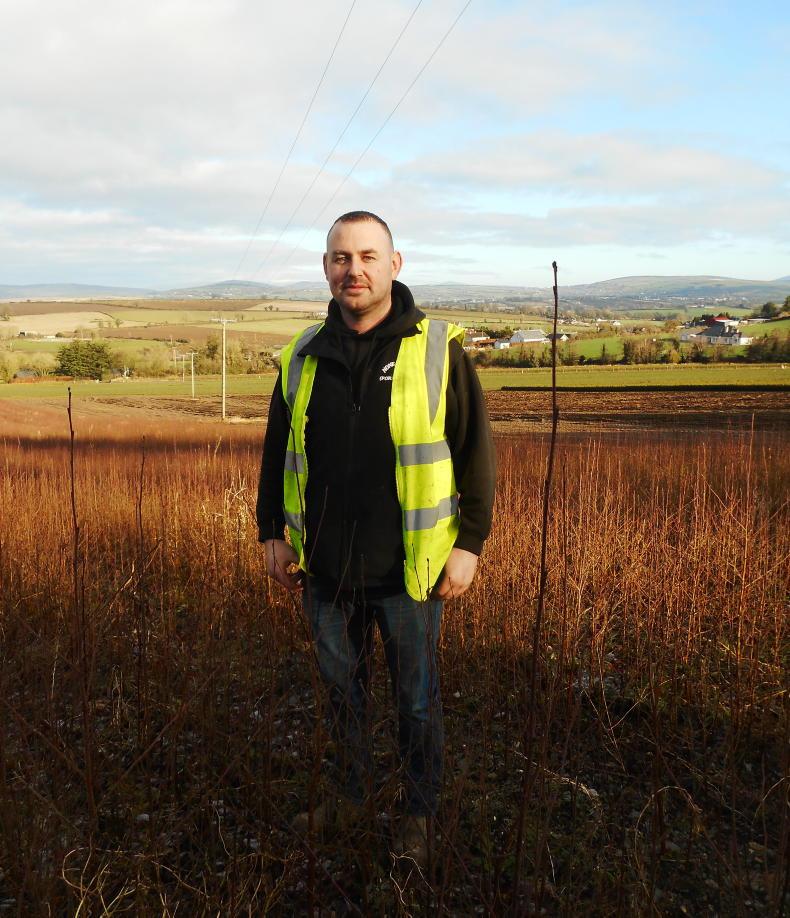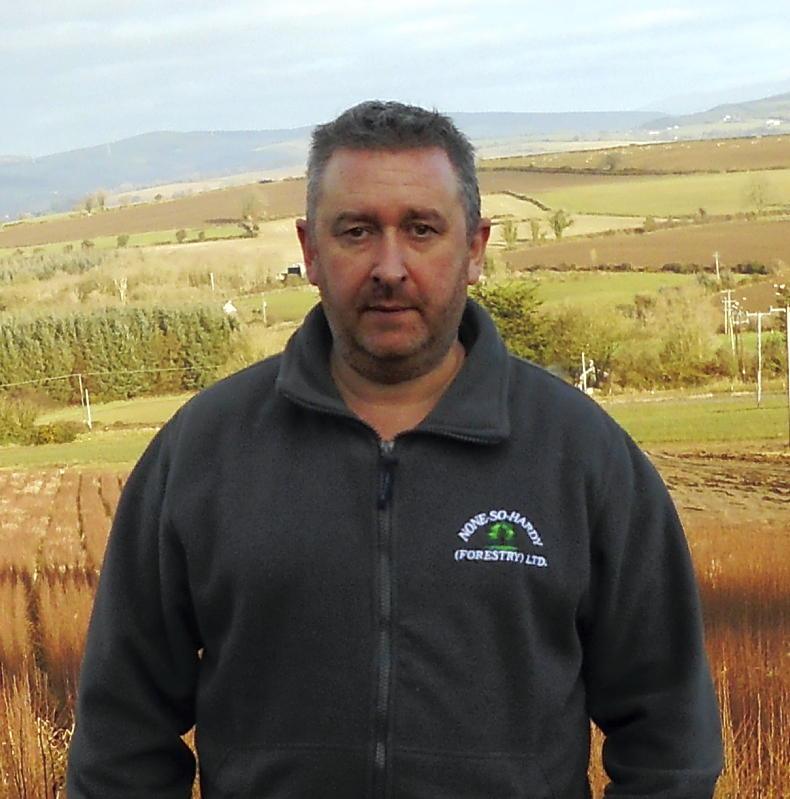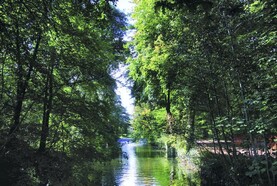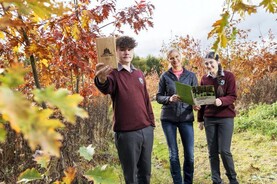The most successful people are those who accept and adapt to constant change.
– Paul Lutus
The first thing visitors to the picturesque Donishal nursery notice is the major reduction of conifer seedbeds and transplant lines.
Situated 3km south of Carnew on the Wicklow-Wexford border, this was once None-so-Hardy’s conifer-only nursery, while the company’s Ballymurn nursery specialises in broadleaves – native and naturalised.
Switching from conifers to broadleaves is the nursery’s response to changing species trends. Coupled with this, the nursery has also to adapt to a rapidly declining afforestation programme.
The nursery has grown used to upheavals in afforestation since it was established in 1985, such as the sudden removal of larch and ash from the afforestation programme in 2011 and 2012.

Ger Byrne, nursery manager, Donishal, stands in birch transplant lines, which a few years ago produced conifers for None-so-Hardy Nursery customers. \ Donal Magner
But the falling afforestation programme in recent years has forced the nursery to reappraise its business model, especially in the 120ha Donishal site, which has a capacity to produce 12 million saleable plants or 4,800ha annually – more than double the annual national afforestation programme.
“We have traditionally grown commercial conifers, such as Sitka and Norway spruce, Scots pine and Douglas fir here, but this is no longer an option,” says Ger Byrne, nursery manager.
Maintaining jobs
None-so-Hardy employs 30 of their 85 staff in Donishal and retaining these is vital for the nursery, as the work is skilled, from seed sowing to lifting and grading.
“The planting downturn also presented difficulties in maintaining employment,” Byrne says. “In March last year, we had to lay off 16 staff during, what normally would be peak season, as plants were left in the ground ungraded, resulting in no work.”
The nursery has maintained staffing levels by exporting plants to Scotland in the recent past and supplying the private reforestation programme in Ireland. Scotland is no longer an option, as UK nurseries have now caught up with demand.
The trend towards planting broadleaves – mainly native – is a new opportunity for Donishal. It is also a major challenge for Byrne, who has been with the company for 25 years:
“I was involved mainly in coniferous plant production during this time and switching to broadleaves is a completely different nursery culture,” he says.
Ground conditions, elevation and soil type all need to be considered, while staff had to opt to different nursery practices.
“Significant investment will also be required to install new irrigation systems, as most broadleaves are more vulnerable than conifers during periods of extreme heat or drought,” he maintains.
Native species
There is also greater diversity and number of tree species, which Byrne rolls off without referring to notes.
In addition to traditional broadleaf production, such as oak and alder, he lists the natives produced in Donishal, including 300,000 whitethorn; 650,000 birch; 20,000 alder; 15,000 crab apple; 20,000 cherry; and 30,000 rowan or mountain ash.
“In production terms, this is a swing of over two million plants, as these broadleaves replaced the same area previously under conifer production,” he says.
“With native species demand now escalating each year, Donishal has transformed over 20ha from conifer to broadleaf production” in the first phase of its species transformation programme.
“The current sales season has seen the first broadleaves ever produced at Donishal and the response from customers has been encouraging,” says Byrne.
However, the nursery will continue to produce commercial conifers, albeit in reduced numbers. He welcomes the re-introduction of hybrid and European larch to the afforestation programme, which the nursery plans to produce.

Teige Ryan, SEEFA, and director at None-so-Hardy: "While we keep pace with rising customer demand for native species, Government must be awoken to the dramatic decline in planting wood-producing species."
“Moving from conifers to broadleaves is not as straightforward as turning off one tap and turning on the next,” he says.
“A major challenge is sourcing native seed. While various merchants both in Ireland and the UK have storage banks of non-native seed, there are no banks for indigenous species,” he says.
“In recent years, we began collecting reproductive forestry material and we also have created a network of seed collectors across the country, because without this initiative, there would be no stock of many of our native species.”
Last year, the nursery planted out native orchards and have earmarked other areas at Donishal to create new seed sources for rowan, cherry, hazel, guelder rose, spindle and crab apple, along with existing thorn hedgerows to underpin future supply.
“Despite the many challenges ahead, the nursery is committed to keeping pace with rising demand, but we need more certainty to maintain future sustainable production,” Ger Byrne says.
Consequences: tree species unpredictability
Predicting future tree species for Ireland’s afforestation programme is fraught with difficulty, especially for nursery owners and managers, as well as foresters and forestry companies. In the longer term, it will affect future planning and investment by timber processors.
“While the nursery embraces the challenges ahead to keep pace with rising customer demand for native species, Government must be awoken to the dramatic decline in planting of our wood producing species,” maintains Teige Ryan, None-so-Hardy director and member of the Social, Economic and Environmental Forestry Association (SEEFA).
“Continual low levels of commercial conifers being planted on new afforestation sites is not even sufficient to compensate for new setback areas and new broadleaf conditions on harvested clearfell sites now being replanted.”
The fluctuating species trends in recent afforestation programmes bears out Ryan’s concerns and illustrate the uncertainty facing the sector. Species such as ash and larch, which formed 11% of the planting programme in 2012, are no longer planted (Table 1).
The drop in Sitka spruce planting is dramatic – 3,576ha to 1,116ha. Provisional returns for last year suggest that approximately 800ha of Sitka were planted.
Commercial conifer programmes have fallen from 4,521ha to 1,253ha during the period 2012-2022, and this trend is likely to continue if the Department’s strategy of achieving at least 50% native species is realised.
Moving from conifers to broadleaves is not as straight-forward as turning off one tap and turning on the next
While the broadleaf share of the planting programme has increased from 32% to 45%, the planting area has halved from 2,131ha to 1,021ha since 2012.
While oak now forms 13% of the planting programme compared with 8% in 2012, the area planted has fallen from 549ha to 300ha.
It’s clear that alder is being reappraised as only 85ha was planted in 2022 compared with 347ha in 2012. Birch, which wasn’t planted at all in 2012, now accounts for 184ha of afforestation.
There is no species breakdown of “additional broadleaves” which include holly, mountain ash and willow.
As this area comprises 15% of the total planting programme, it is now sufficiently large to merit a breakdown of species.
The most successful people are those who accept and adapt to constant change.
– Paul Lutus
The first thing visitors to the picturesque Donishal nursery notice is the major reduction of conifer seedbeds and transplant lines.
Situated 3km south of Carnew on the Wicklow-Wexford border, this was once None-so-Hardy’s conifer-only nursery, while the company’s Ballymurn nursery specialises in broadleaves – native and naturalised.
Switching from conifers to broadleaves is the nursery’s response to changing species trends. Coupled with this, the nursery has also to adapt to a rapidly declining afforestation programme.
The nursery has grown used to upheavals in afforestation since it was established in 1985, such as the sudden removal of larch and ash from the afforestation programme in 2011 and 2012.

Ger Byrne, nursery manager, Donishal, stands in birch transplant lines, which a few years ago produced conifers for None-so-Hardy Nursery customers. \ Donal Magner
But the falling afforestation programme in recent years has forced the nursery to reappraise its business model, especially in the 120ha Donishal site, which has a capacity to produce 12 million saleable plants or 4,800ha annually – more than double the annual national afforestation programme.
“We have traditionally grown commercial conifers, such as Sitka and Norway spruce, Scots pine and Douglas fir here, but this is no longer an option,” says Ger Byrne, nursery manager.
Maintaining jobs
None-so-Hardy employs 30 of their 85 staff in Donishal and retaining these is vital for the nursery, as the work is skilled, from seed sowing to lifting and grading.
“The planting downturn also presented difficulties in maintaining employment,” Byrne says. “In March last year, we had to lay off 16 staff during, what normally would be peak season, as plants were left in the ground ungraded, resulting in no work.”
The nursery has maintained staffing levels by exporting plants to Scotland in the recent past and supplying the private reforestation programme in Ireland. Scotland is no longer an option, as UK nurseries have now caught up with demand.
The trend towards planting broadleaves – mainly native – is a new opportunity for Donishal. It is also a major challenge for Byrne, who has been with the company for 25 years:
“I was involved mainly in coniferous plant production during this time and switching to broadleaves is a completely different nursery culture,” he says.
Ground conditions, elevation and soil type all need to be considered, while staff had to opt to different nursery practices.
“Significant investment will also be required to install new irrigation systems, as most broadleaves are more vulnerable than conifers during periods of extreme heat or drought,” he maintains.
Native species
There is also greater diversity and number of tree species, which Byrne rolls off without referring to notes.
In addition to traditional broadleaf production, such as oak and alder, he lists the natives produced in Donishal, including 300,000 whitethorn; 650,000 birch; 20,000 alder; 15,000 crab apple; 20,000 cherry; and 30,000 rowan or mountain ash.
“In production terms, this is a swing of over two million plants, as these broadleaves replaced the same area previously under conifer production,” he says.
“With native species demand now escalating each year, Donishal has transformed over 20ha from conifer to broadleaf production” in the first phase of its species transformation programme.
“The current sales season has seen the first broadleaves ever produced at Donishal and the response from customers has been encouraging,” says Byrne.
However, the nursery will continue to produce commercial conifers, albeit in reduced numbers. He welcomes the re-introduction of hybrid and European larch to the afforestation programme, which the nursery plans to produce.

Teige Ryan, SEEFA, and director at None-so-Hardy: "While we keep pace with rising customer demand for native species, Government must be awoken to the dramatic decline in planting wood-producing species."
“Moving from conifers to broadleaves is not as straightforward as turning off one tap and turning on the next,” he says.
“A major challenge is sourcing native seed. While various merchants both in Ireland and the UK have storage banks of non-native seed, there are no banks for indigenous species,” he says.
“In recent years, we began collecting reproductive forestry material and we also have created a network of seed collectors across the country, because without this initiative, there would be no stock of many of our native species.”
Last year, the nursery planted out native orchards and have earmarked other areas at Donishal to create new seed sources for rowan, cherry, hazel, guelder rose, spindle and crab apple, along with existing thorn hedgerows to underpin future supply.
“Despite the many challenges ahead, the nursery is committed to keeping pace with rising demand, but we need more certainty to maintain future sustainable production,” Ger Byrne says.
Consequences: tree species unpredictability
Predicting future tree species for Ireland’s afforestation programme is fraught with difficulty, especially for nursery owners and managers, as well as foresters and forestry companies. In the longer term, it will affect future planning and investment by timber processors.
“While the nursery embraces the challenges ahead to keep pace with rising customer demand for native species, Government must be awoken to the dramatic decline in planting of our wood producing species,” maintains Teige Ryan, None-so-Hardy director and member of the Social, Economic and Environmental Forestry Association (SEEFA).
“Continual low levels of commercial conifers being planted on new afforestation sites is not even sufficient to compensate for new setback areas and new broadleaf conditions on harvested clearfell sites now being replanted.”
The fluctuating species trends in recent afforestation programmes bears out Ryan’s concerns and illustrate the uncertainty facing the sector. Species such as ash and larch, which formed 11% of the planting programme in 2012, are no longer planted (Table 1).
The drop in Sitka spruce planting is dramatic – 3,576ha to 1,116ha. Provisional returns for last year suggest that approximately 800ha of Sitka were planted.
Commercial conifer programmes have fallen from 4,521ha to 1,253ha during the period 2012-2022, and this trend is likely to continue if the Department’s strategy of achieving at least 50% native species is realised.
Moving from conifers to broadleaves is not as straight-forward as turning off one tap and turning on the next
While the broadleaf share of the planting programme has increased from 32% to 45%, the planting area has halved from 2,131ha to 1,021ha since 2012.
While oak now forms 13% of the planting programme compared with 8% in 2012, the area planted has fallen from 549ha to 300ha.
It’s clear that alder is being reappraised as only 85ha was planted in 2022 compared with 347ha in 2012. Birch, which wasn’t planted at all in 2012, now accounts for 184ha of afforestation.
There is no species breakdown of “additional broadleaves” which include holly, mountain ash and willow.
As this area comprises 15% of the total planting programme, it is now sufficiently large to merit a breakdown of species.








 This is a subscriber-only article
This is a subscriber-only article










SHARING OPTIONS: